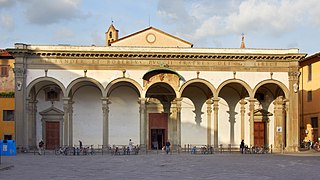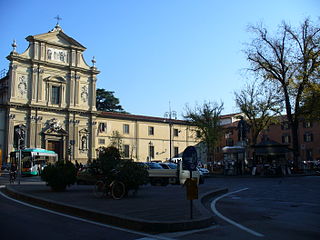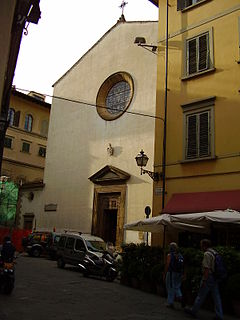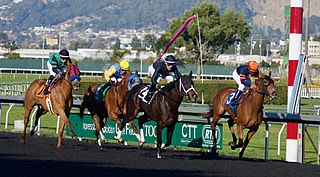
Donato di Niccolò di Betto Bardi, better known as Donatello, was an Italian sculptor of the Renaissance. Born in Florence, he studied classical sculpture and used this to develop a complete Renaissance style in sculpture, whose periods in Rome, Padua and Siena introduced to other parts of Italy a long and productive career. He worked with stone, bronze, wood, clay, stucco and wax, and had several assistants, with four perhaps being a typical number. Though his best-known works were mostly statues in the round, he developed a new, very shallow, type of bas-relief for small works, and a good deal of his output was larger architectural reliefs.

The Basilica della Santissima Annunziata is a Renaissance-style, Roman Catholic minor basilica in Florence, region of Tuscany, Italy. This is considered the mother church of the Servite Order. It is located at the northeastern side of the Piazza Santissima Annunziata near the city center.

The Chiesa di San Felice is a Roman Catholic church in Florence, region of Tuscany, Italy. It is located on the south bank of the River Arno, just west of the Pitti Palace. It is predominantly Gothic, but has a Renaissance façade by Michelozzo, added in 1457. Over the high altar is a large Crucifix attributed to Giotto or his school.

Michelozzo di Bartolomeo Michelozzi (1396–1472) was an Italian architect and sculptor. Considered one of the great pioneers of architecture during the Renaissance, Michelozzo was a favored Medici architect who was extensively employed by Cosimo de' Medici. He was a pupil of Lorenzo Ghiberti in his early years and later collaborated with Donatello.

The Palazzo Medici, also called the Palazzo Medici Riccardi after the later family that acquired and expanded it, is a Renaissance palace located in Florence, Italy. It is the seat of the Metropolitan City of Florence and a museum.

Agostino di Duccio was an early Renaissance Italian sculptor.

Impruneta is a town and comune of the Metropolitan City of Florence in the Italian region of Tuscany. The population is about 15,000.

The Villa Medici at Careggi is a patrician villa in the hills near Florence, Tuscany, central Italy.

San Marco is the name of a religious complex in Florence, Italy. It comprises a church and a convent. The convent, which is now the Museo Nazionale di San Marco, has three claims to fame. During the 15th century it was home to two famous Dominicans, the painter Fra Angelico and the preacher Girolamo Savonarola. Also housed at the convent is a famous collection of manuscripts in a library built by Michelozzo.

Museo Nazionale di San Marco is an art museum housed in the monumental section of the medieval Dominican friary dedicated to St Mark, situated on the present-day Piazza San Marco, in Florence, region of Tuscany, Italy.

The Villa Medicea di Cafaggiolo is a villa situated near the Tuscan town of Barberino di Mugello in the valley of the River Sieve, some 25 kilometres north of Florence, central Italy. It was one of the oldest and most favoured of the Medici family estates, having been in the possession of the family since the 14th century, when it was owned by Averardo de' Medici. Averardo's son, Giovanni di Bicci de' Medici, is considered to be the founder of the Medici dynasty.

The Magi Chapel is a chapel in the Palazzo Medici Riccardi of Florence, Italy. Its walls are almost entirely covered by a famous cycle of frescoes by the Renaissance master Benozzo Gozzoli, painted around 1459 for the Medici family, the effective rulers of Florence.

The Tomb of Antipope John XXIII is the marble-and-bronze tomb monument of Antipope John XXIII, created by Donatello and Michelozzo for the Florence Baptistry adjacent to the Duomo. It was commissioned by the executors of Cossa's will after his death on December 22, 1419 and completed during the 1420s, establishing it as one of the early landmarks of Renaissance Florence. According to Ferdinand Gregorovius, the tomb is "at once the sepulchre of the Great Schism in the church and the last papal tomb which is outside Rome itself".
Pagno di Lapo Portigiani was an Italian Renaissance decorative sculptor, a minor follower of Donatello who worked on numerous occasions in projects designed and supervised by Michelozzo.

The Villa del Trebbio is a Medici villa in Tuscany, Italy.

The Tomb of Cardinal Rainaldo Brancacci is a sculptural work in the church of Sant'Angelo a Nilo in Naples, southern Italy, executed by Donatello and Michelozzo around 1426-1428. Built in marble, partly gilt and polychrome, it has a height of 11.60 meters and a width of 4.60.

San Girolamo is a Renaissance style church just outside the old walled city of Volterra, Italy. The church and attached Franciscan convent, a complex also known as of San Girolamo al Velloso, were designed by Michelozzo and construction was completed by about 1445. Some have questioned the attribution and even suggested that it was designed another famous Florentine architect, Lorenzo Ghiberti.

San Niccolò Oltrarno is a Roman Catholic church located on Via San Niccolò in the district of the same name in Florence, region of Tuscany, Italy. The narrow district of Niccolò in Oltrarno is hemmed between the hills around San Miniato and the river.



















